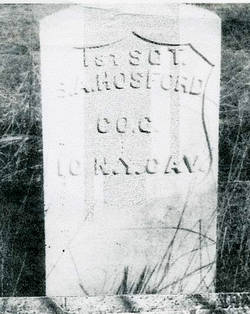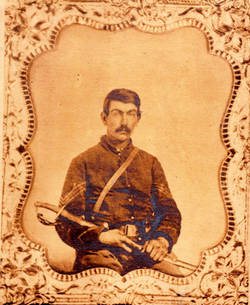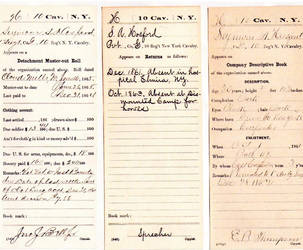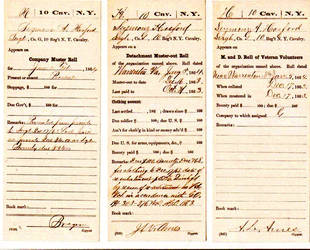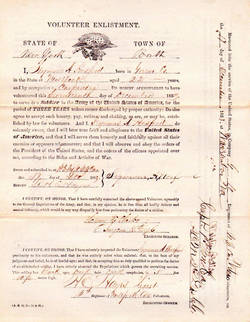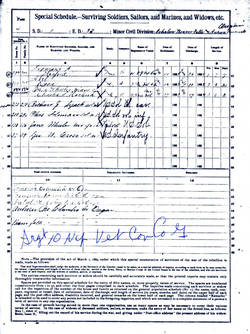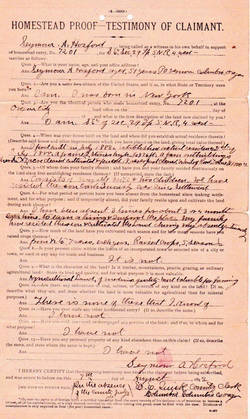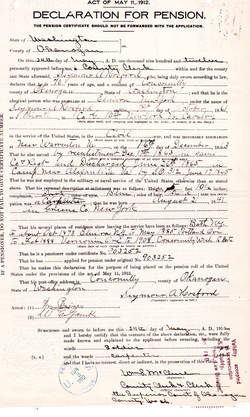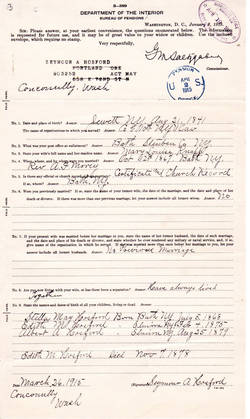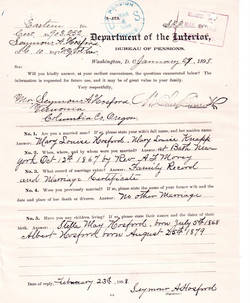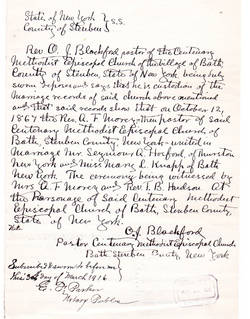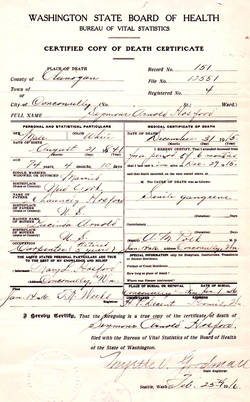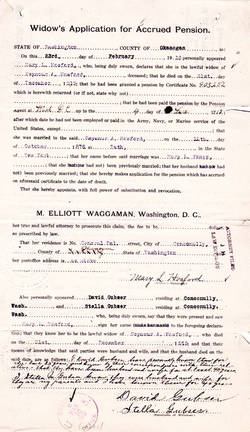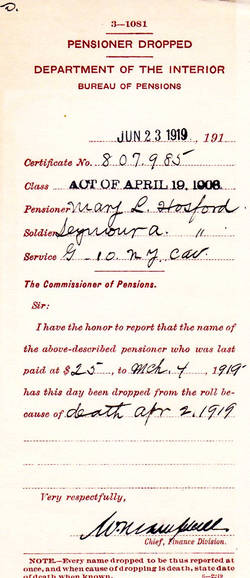Seymour A. Hosford
Representing: Union
Unit History
- 10th New York Cavalry G
- 1st New York Provisional Cavalry G
Full Unit History
10th NEW YORK VOLUNTEER CAVALRY
Organized: Fall, 1861 Elmira, NY
Mustered In: 9/61 - 12/62 by companies
Disbanded By Consolidation: 6/17/65
1st NEW YORK VOLUNTEER PROVISIONAL CAVALRY
Organized By Consolidation: 6/17/65
Mustered Out: 7/19/65 Cloud's Mills, VA
Regimental History
REGIMENTAL HISTORY: (10th)
The 10th, a three year, eastern theater regiment also known as the Porter Guard, contained companies recruited in the New York State counties of Chemung, Chenango, Cortland, Erie, Fulton, Onondaga and Steuben. Companies “A" through "H" were mustered into U.S. service from late September to late December, 1861; "I," "K," and "L" were mustered in late October, 1862 and "M" was mustered in between November and December, 1862. The first eight companies left the state on 12/24/61 and were stationed at Gettysburg, PA the remainder of the winter. In the spring and summer of '62 the unit did railroad guard duty and served in the defenses of Washington City. It saw its first active service in the 2nd Manassas, VA campaign that August and was present at Fredericksburg in December.
1863. Around the first of May the regiment participated in the Stoneman cavalry raid into Virginia. It encountered its hardest fighting at Brandy Station in June, 1863 losing 6 killed, 18 wounded and 61 missing. Actions to follow that year and into 1864 included. Middleburg, Sulphur Springs, Auburn, Bristoe and Catlett' stations, Haw's Shop, Hanoverton, Trevilian Station, St. Mary's Church and Boydton Road. Additionally, there were many engagements during the 1864/'65 siege and taking of Petersburg. During the final Appomattox campaign the 10th’s aggregated losses were 72 killed, wounded or missing. In all, the regiment's combat record earned its inclusion in Fox's listing of the three hundred fightingest Federal regiments during the War of the Rebellion.
The war ended and the Federal government trying to cut costs by de-activating or consolidating military units, on 6/17/65 the 10th was ordered to be merged with the members of the 24th NY Cavalry to form the 1st Provisional NY Cavalry. That consolidation was completed on 7/10/65.
REGIMENTAL HISTORY: (1st)
The American Civil War officially ended in May, 1865. The victorious U.S. Government thus began to eliminate or consolidate (combine) military units to save money. As such, under orders from the War Department issued on 6/17/65, the 10th and 24th regiments of New York cavalry were joined and designated the 1st Provisional New York Cavalry. The 6/17 date was on paper only. The actual, physical consolidation took place on 7/10/65, with company to corresponding company. The 1st was mustered out and honorably discharged 7/19/65 at Cloud's Mills, VA.
Soldier History
SOLDIER: (10th)
Residence: Thurston, Steuben Co., NY Age: 20.1 yrs.
Enlisted/Enrolled: 10/1/61 Bath, NY Rank: Sgt.
Mustered In: 12/28/61 to date 11/16/61
Transferred Out: 6/17/65
Highest Rank: 1st Sgt.
SOLDIER: (1st)
Residence: Thurston, Steuben Co. NY Age: 23.10 yrs.
Transferred In: 6/17/65 Rank: 1st Sgt.
Mustered Out: 7/19/65 Cloud's Mills, VA
Highest Rank: 1st Sgt.
Family History
PERSONAL/FAMILY HISTORY:
NOTE: During the American Civil War Seymour Hosford served in a U.S. cavalry unit. While in the field he wrote and sent many letters home to his parents. A number of those letters are presented herein. Please be it noted that Civil War era letters do not contain the sentence structure and punctuation of today's writings. Also, there may be some inaccuracies due to your Obedient Servant's transcription abilities!!! Writer/Editor, R.B. Smith
*****************************************************************************
Seymour Arnold Hosford was born in Jewett, Greene County, New York on August 21, 1841. His parents were Chauncy (b. 1798 NY) and Lucinda (nee Arnold b. 1805 NY) Hosford. The Hosfords were a farm family. The U.S. Census of 1850 noted Seymour's in-home siblings as: Olin (b. 1825 NY), Reuben (b. 1828 NY) and Catherine (b. 1832 NY).
On October 1, 1861 not long after the onset of the War of The Rebellion, twenty year old Seymour enlisted in the U.S. Cavalry for three years. Statistical information gathered at the time showed him to be five foot ten and one half inches in height, being dark complexioned, having dark/blue eyes and dark hair. His enlistment date occupation was noted as "carpenter." After being mustered into the military in December, one of his first recorded experiences occurred that same month when he was listed as being "absent sick" - apparently in the U.S. military hospital located in Elmira, NY. As of this writing the nature of that illness is not known.
1862. For most of that year medical issues continue to be front and center for Seymour. In mid- March - the 15th to the 17th - he was sidelined for treatment of influenza.
On the 17th of July, 1862, Seymour wrote the following letter to his parents from Virginia: “We do not overwork ourselves having no long marches to make with heavy knapsacks to carry, but we ride (on foot you know). The excitement about our moving seems to have died away and I dont care if we stay here very long....I heard that George Clark died (Note: An attempt was made to further identify this soldier, but with many George Clarks serving the Union during The War, the attempt was not successful.) in the Hospital at Yorktown (VA) but did not hear whether he was wounded or died of some disease....we live prety easy up here. I have just been fishing...out a little over an hour three of us. we caught 75 white perch and four eels, but do not live quite as good as we did because we cannot keep fresh meat and when we get potatoes they are unfit to eat. We get some berrys that are very good....We don't have any butter to eat on bread. Last night I was out of camp and I had a good supper...had a Tumbler to drink out of (and) ate on a plate (not a tin one either) had some fried eggs milk and Cucumbers....I have got acquainted with the folks, but the way I went I found a good many secesh. some of them I think I shall try and get better acquainted with....The only thin I am troubled with is laziness but it does not lay me up but little...when we first began to drill we drilled in two ranks and last winter they got up a new system of Tactics..we have been drilled in that till within a few days and had got so that we could drill pretty well...now we have been ordered back in old tactics again...I have not drilled a squad since the Captain resumed the command....Things getting a little more quiet than it was a couple weeks ago. I have heard that the captain has applied to have a number of the Non Commissioned Officers Reduced to the Ranks but I don't think the Colonel will do it for he knows the Boys as well as the Capt. and he cant fill there places with as good men from the Co for hasnt got them. If he makes the alternations he talks of I shall pull off my stripes......
From August into December trooper Hosford was under medical care for diarrhea which would result in his getting up from his tent many times at night. As a result, under doctor's orders he was "excused from duty" several times. Still, his service was exemplary as, on 12/29/62, he was promoted from 3rd duty sergeant to 2nd sergeant. . He talked of the promotion in the following 2/2/63 letter written in camp at Beyard, VA: I rec'd your letter of the 24th and also of the 27th with the compass and a paper and I assure you I was glad to get them....I have receive 4 or 5 papers lately...since we got settled...but you speak of 2 or 3 letters that I have not rec'd....It has been raining all day and about 3 o'clock it commenced snowing, a wet snow almost rain mostly. Shortly after it began I heard the Bugle sound the Officers call and boots and saddles. and we had to start off with 2 days rations, the mud knee deep. We rode about 1 miles and then stopped in a piece of pine woods...and stayed all night. In the morning we moved about a mile and the most of the Regt. was sent out to look after Deserters from our Co.
Was on the reserve so did not go out. I suppose you think it is nice to bring up in the woods in the middle of the night almost froze and then after starting fires to think of sleeping with the trees almost breaking down with the snow on them and sifting down on you and no Feather bed along with you. but after all we did not catch a man while we were out. the Capt. was put under arrest this morning for not being up at time for roll call there was a no. of others beside him. (I say Bully for them) you have asked at least a half dozen times what Office I hold and I have told you many times it is Second Duty Sergeant (words underlined). I have been promoted clean up to 2nd and now I expect to be put in the ranks....I hope so any for I hate the Capt. and so does all the Co.; he would use the men worse than Brutes if he dared. tie them to a tree for the least ofense and keep them there a half day or longer with a rope around their thumbs tied up so as to make them stand on tiptoe....if you have got it to spare send a few shillings for I don't know when we will be paid before March and I could buy some flour and make pan cakes (wheat of course)......"
On March 9, 1863 at Brandy Station, VA during the largest cavalry battle of the war, a spent cannon ball struck Sgt. Hosford in the left side and knocked the wind out of him. He complained about the side injury a long time after and wrote home about it in a letter dated 6/11/63 from the 10th NY Cavalry Headquarters in Warrington (Warrenton), VA: "I thought I wuld write to you and let you know that I am about as sound as I was before...with the exception of having the rheumatism slight in the left side caused probbly by stopping a ten pound cannon ball a little too soon. We started from camp Monday the 8th and went to Kelley's Ford, stayed overnight. The next morning we crossed the (Rappahannock) river. We could hear the cannon all morning. We took the road to Brandy Station but did not seem to get much nearer to the firing until within two miles of the station when we turned right and it began to get nearer to us. All at once we came to (the) edge of the woods and they were firing at a good rate less than a half a mile from us. We kept on into the field when the Rebs slacked their fire in the Battery and turned part of their guns on us. The shells came flying around us plenty think enough for timid folks. We formed in line and sent out half of our Squadron as skirmishers. We were then ordered to advance and charge the Rebs but the Harris light ran ahead of (us) and then wheeled and broke up so that we had to go back and form again. (Union cavalry Gen. George) Kilpatrick swore at the Harris light, told them they were a disgrace to the battlefield. After we reformed we were ordered to support a Battery that was going up a little knoll. Just before we go to the top of the rise we were (told) there was a Regt. of Rebs just the other side. Kilpatrick ordered us to charge them and we did but had to back out for they had nearly five to one, but we layed a good many of them out. It was hand to hand and the Sabre made back work. We have only four missing from our Co. Co. C has 19 in the whole regt 103, four commissioned officers and the colonel. Lieut. King of our Co. is one of the missing. I came very near getting dismounted right in the thickest of it. I could not hold my horse. Asa Story is one of the missing ones but we think he is not killed. We got Col. Irvines horse he was wounded in three Places. After the charge we were marching across a field and they opened up on us with 10 pound gun(s). (One of) the shots truck 25 rods short of us, bounded about 20 rods, then bounded again and hit me in the left side but did not knock me from the horse. They all thought I was killed but I was all right in a half an hour. I felt better as soon as I could get my breath. It doesn't bother me but little now so I rode 10 miles yesterday morning. I Want you to send me a pocket compass as I mean to send you the one one I have now. The edge of the (solid) shot touch it and spoiled it. I will send this in (a) secsh enevelope take(n) on the battlefield.....The fight lasted just 2 hours and a half after our first charge. We expect to move tomorrow as it is thought the Rebs are going in Md again and our atack was to hinder them."
The battle of Gettysburg, PA July 1, 2 and 3, 1863, was to follow. It was noted by Sgt. Hosford in the following missive: "8/20/63 camp near Catlett Sta, VA Headquarters - I have not much to write to you but I thought I would let you know that I am well and Have not forgot you. We are campted now in a nice piece of woods smooth and level with just trees enough to make a shade and nothing to do but keep as comfortable as possible it is so warm that we do not like to get exited much. I heard some heavy guns this morning I think in the direction of Fredericksburg but have not heard anything about it yet and dont know what our men or the Rebs are doing but everything seems to be quiet just now. Our Division is doing a little picket duty and go out occasionally on a scout. We have not been out since we came back fom the other side of the river last Saturday....it was the third time we have been south of the river and the only one that we did not have to fight-but I have been well contented to come back without having a battle and I have heard Balls enough whistle by my ears and I have been hit twice by glancing shots but did not get hurt much either time. I have not felt anything from the big ball since I went into Maryland until two or three days ago when it hurt me some to ride for two mornings but that the was the last of it. at Gettysburg a minie ball glanced and touched me on the arm but did not hurt me any. We have got a Captain once more. his name is Burton D. Porter he used to be a Quarter Master Sgt. in our Co. but he got a chance to go Recruiting last fall and he got a position as first Lieut in one of the Companies and now he has got a commission as a Captain in our Co. I suppose we will lose Lieut. McKevitt for he says he can get a discharge if he wants to. He had heard that they had appointed a Captain and said if he found it was true he would take it - he was very badly wounded and said he had to keep very quiet or the Docktor said his lungs would commence bleeding and kill him instantly.....I think you will be well....to call at the Office of the Expess Co.....I think you will find a Greenback of $20.00 value."
October 17, 1863 saw Sergeant Hosford leave his regiment for dismount camp where he would be rehorsed. On December 16th he was mustered out of the service because of the expiration of his first period of enlistment. The following day, however, he reenlisted as a veteran volunteer in his same regiment and company. For reenlisting he received a $400 enlistment bonus or "bounty", $60 of which was initially paid with the balance to be paid in later increments. While available records do not note it, likely he also received a 30 furlough home to which he would apparently allude to in his next letter home. Although his re-enlistment was as a private, the same day he was promoted back to the rank of sergeant.
Sergeant Hosford's next letter is dated March 5, 1864 and was written in or near Alexandria, VA: “As we are to stop here till tomorrow....We arrived here this morning after two nights in Washington. We had a very good time there. I was out in the city 3 times. Saw the President at the theatre last night. It was a splendid affair. We expect to go on again in the morning. It will only take a few hours to go from here to our camp....We have had something of a tedious time in coming through but we lived pretty well most of the time. We left new York the morning after I wrote you, got to Philadelphia just at night and to Baltimore the next morning about 9 o'clock and to Washington about 7."
During a June raid to Trevilian Station, VA Sergeant Hosford not only lost his mount, but suffered a severe – apparently his second – bout of sunstroke. Without a hose he once again returned to the dismount camp. He appears to have returned to his unit sometime in September/October. The following month he was again promoted, this time to 1st sergeant.
March 16, 1865. Camp near Warrenton, VA:” no news to write everything is dull as usual but is seems very natural I have been on picket twice since we got back. we have got 15 or 16 new recruits here already and expect more in a few days. We are pretty well crowded now. When we got back we only found two or three tents besides the ones we left our things in and but a very few saddle blankets. they had all been stolen. I have been looking for a letter from you but I have been disappointed so far....They have Balls at Warrenton every few nights but I have not been up there since I came back so Don't know what kind of times they have.....
First Sergeant Hosford's next letter home comes from March 22, 1865. From rumors, he has an inkling the War was grinding to a close:"....I have no news to write. They keep me pretty busy now days. We have got 17 drafted men and substitutes and 3 men that were deserters. They have great times with thim on picket, they are more dangerous than the Rebs. Only a few days ago one of them shot a corporal dead and one of ours came very near to shooting the corporal. He was asleep when they went to relieve him and he was going to shoot the first thing when he was waked, and one was killed here in camp. They were handling a gun and it went off killing one of them instantly.....Here it is uncommonly dry weather for this time of the year. For my part Id had rather have a little more rain and then I would not have so much to do.....The boys in the 5th Corps think the war is going to close without any more fighting I suppose they hope so and try to think it will be so. I will send you a couple papers with the account of Sherm(an)’s great march through South Carolina and Georgia...you may not get as good an account in your paper. The whole of our Regt. is now armed with Spencers Seven Shooting Carbine(s) so if we have fight any more we can do a good business." The next day he added: "We are expecting to be reviewed by the President, have been waiting nearly two days. I suppose it will be a great time."
The last wartime letter to be sent home by First Sgt. Hosford comes from the 10th Cavalry camp at Petersburg, VA. President Lincoln had been assassinated and, except on paper, four years of bloody Civil War had ended: "...we have orders to be ready for a 15 mile march and we expect to start tomorrow morrn if nothing should happen to prevent (it)....Everything is quiet about here at present. We have not been doing much since the surrender we do not know where we are going to now but there is a rumor quite prevalent that we are to guard the 9th Corps wagon train to Washington....I am in hopes that it is true. another story is that we are to be sent home on halfpay and are to be in readiness to come back into the field any time that we should be called on....I see by the papers that the people are very much exceited over the assasination of the President but I do not think it affects the citizen as it does the Soldiers for I do not think that they realize how much he has done for the country and most of them do not have but a very faint idea of what war is. no one suffers no one knows what it is to live without a morsel to eat for days at a time.....our men were never in better spirits nor ever fought better than they did this spring....I want to know now whether if I should get home this summer I could make a living and how. this has caused me more trouble than anything else. when you write I want you to tell me something about the place. you never say anything about my grapes or anything else about it."
Military financial accounts settled, First Sergeant Seymour Hosford was mustered out of the service on June 26th at St. Cloud/Cloud's Mills, VA. At final muster, at least on paper, he was a member of the 1st New York Provisional Cavalry. While we know he settled in Bath, Steuben County, New York, the nature of his initial post-war occupation is not documented.
***************************************************************************
On October 12, 1867 in Bath, New York former cavalryman Seymour Hosford married Mary Louise Knapp (b. 1/30/49 Bath, NY). The wedding was the first for both. The union would produce three children: Stella May (b.7/5/68 NY), Edith M. (b. 2/4/75 Elmira, NY - d. 11/1 or 7/78 Elmira, NY) and Albert A. "Bertie" (b. 8/25/79 Elmira, NY).
The U.S.Census for 1870 placed the Hosford family in Bath, Steuben Co., NY with Seymour listing his occupation as in pre-war days, as "carpenter." Also in the home, besides wife Mary and daughter Stella was Mary's fifteen year old sister, Ella M. Knapp.
While one source indicates the Hosfords quitted Bath, New York for Elmira, Chemung Co., NY circa October/November, 1872, available pension documents point to the year as having been 1873. Stimulus for the move may well have been Seymour - , noted as being an excellent carpenter and cabinet maker - obtaining a job in a shop constructing railroad passenger cars.
The Hosfords remained in Elmira until May, 1885, when - for an undocumented reason - they jumped across the county to the vicinity of Portland, Multnomah County, Oregon. There, on 12/4/87 at the Oregon City land office $16 was paid by Seymour for a 60 (or 160) acre homestead which was likely located not in the Portland area, but in Vernonia, Columbia County, Oregon. The Hosford address at the time of the homestead payment was noted as "East Portland." In February, 1888 they apparently moved to Vernonia and, in May of that year settled on their homestead land and began building a house/home. Actual residence in that structure came either in July or September ‘88. Thereafter the homestead was described as follows: House - 16’ x 26' wood frame 2 stories high, a barn and outbuildings. Seven acres of timber cut for the planting of an orchard, cultivation and pasture. A portion or perhaps all of the cultivated and planted land was fenced. A 1/4 road led to the site which, in 1890, was addressed as being in Auburn, Columbus County, Oregon.
Three years later, Seymour began the paperwork process to obtain permanent title to his homesteaded land. At that time it was noted that the family had lived continuously on the property, he only being absent from same three times for a period of three or four months in order to earn a living for homestead improvements. During his absence his wife and family cultivated and plowed. Ultimately eighteen acres were cleared for raising crops which was done on one half to seven acres over four or five seasons. Interestingly, the land was described as being only of "medium agricultural" quality.
The census for 1900 located The Hosfords still living in Auburn, Columbus County, Oregon, but circa 1908 they quitted their Oregon homestead and moved to the state of Washington, choosing to settle in or near the community of Conconully located in north central part of that state’s Okanogan County. Why this transition was made is not documented. The census of 1910 noted Seymour and Mary Louise in Conconully with Seymour still noted, by trade, as a carpenter. That year, however, would also see him retire from that occupation.
It was in Conconully that, after years of collecting affidavits and filling out paperwork pertaining to illnesses such as chronic diarrhea and sunstroke which had afflicted Seymour while in the service of his country and continued to plague him in civilian life, the former cavalry sergeant was finally granted a U.S. Government disability pension. That pension commenced at the rate of $25 per month on June 3, 1912.
Seymour's pensioned retirement would be relatively short lived. On 12/31/15, in Conconully, WA the former Civil War cavalry trooper died. Cause of death for the 74.4 year old was listed as "senile gangrene." Burial was in the Conconully community cemetery.
Following her husband's passing Mary Louise applied for and was granted a portion of her late spouse's government pension stipend. That stipend had grown to $25 per month at the time of her passing in Conconully on April 2, 1919. She was buried beside Seymour in the Conconully cemetery.
Cemetery
Buried at Conconully Pioneers Rest Cemetery
Adopt-a-Vet Sponsor
Requester: Elizabeth (Betty) Hosford Hartsfield
Mill Creek, WA
